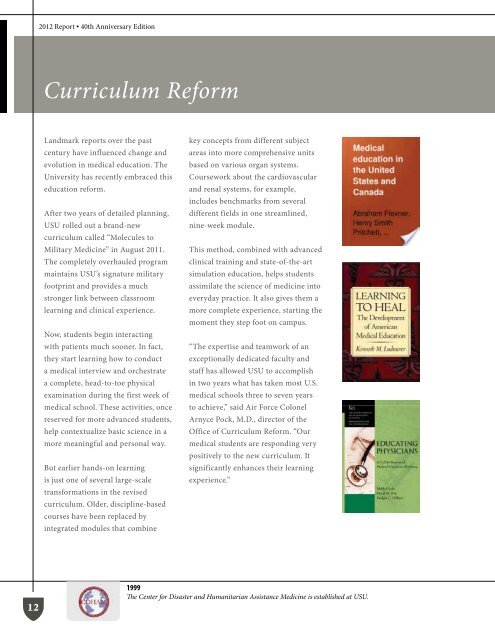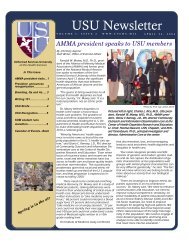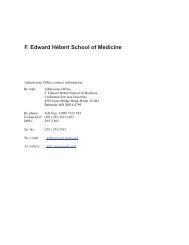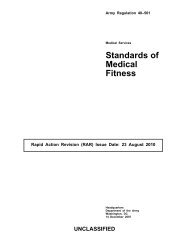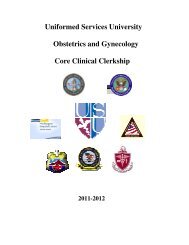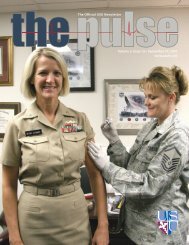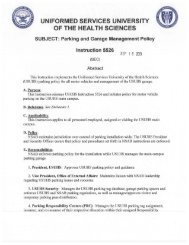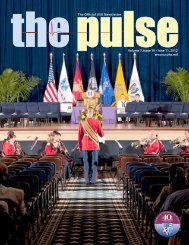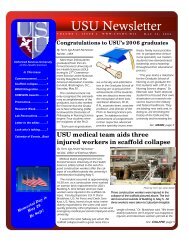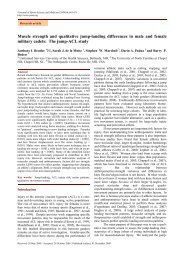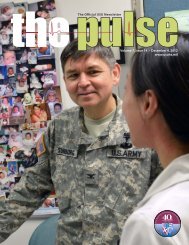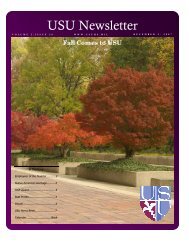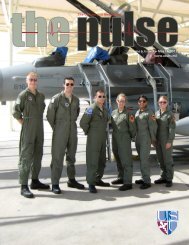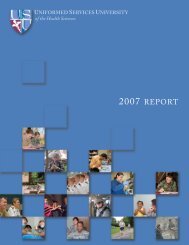2012 Annual Report - Uniformed Services University of the Health ...
2012 Annual Report - Uniformed Services University of the Health ...
2012 Annual Report - Uniformed Services University of the Health ...
You also want an ePaper? Increase the reach of your titles
YUMPU automatically turns print PDFs into web optimized ePapers that Google loves.
<strong>2012</strong> <strong>Report</strong> • 40th Anniversary Edition<br />
Curriculum Reform<br />
Landmark reports over <strong>the</strong> past<br />
century have influenced change and<br />
evolution in medical education. The<br />
<strong>University</strong> has recently embraced this<br />
education reform.<br />
After two years <strong>of</strong> detailed planning,<br />
USU rolled out a brand-new<br />
curriculum called “Molecules to<br />
Military Medicine” in August 2011.<br />
The completely overhauled program<br />
maintains USU’s signature military<br />
footprint and provides a much<br />
stronger link between classroom<br />
learning and clinical experience.<br />
Now, students begin interacting<br />
with patients much sooner. In fact,<br />
<strong>the</strong>y start learning how to conduct<br />
a medical interview and orchestrate<br />
a complete, head-to-toe physical<br />
examination during <strong>the</strong> first week <strong>of</strong><br />
medical school. These activities, once<br />
reserved for more advanced students,<br />
help contextualize basic science in a<br />
more meaningful and personal way.<br />
But earlier hands-on learning<br />
is just one <strong>of</strong> several large-scale<br />
transformations in <strong>the</strong> revised<br />
curriculum. Older, discipline-based<br />
courses have been replaced by<br />
integrated modules that combine<br />
key concepts from different subject<br />
areas into more comprehensive units<br />
based on various organ systems.<br />
Coursework about <strong>the</strong> cardiovascular<br />
and renal systems, for example,<br />
includes benchmarks from several<br />
different fields in one streamlined,<br />
nine-week module.<br />
This method, combined with advanced<br />
clinical training and state-<strong>of</strong>-<strong>the</strong>-art<br />
simulation education, helps students<br />
assimilate <strong>the</strong> science <strong>of</strong> medicine into<br />
everyday practice. It also gives <strong>the</strong>m a<br />
more complete experience, starting <strong>the</strong><br />
moment <strong>the</strong>y step foot on campus.<br />
“The expertise and teamwork <strong>of</strong> an<br />
exceptionally dedicated faculty and<br />
staff has allowed USU to accomplish<br />
in two years what has taken most U.S.<br />
medical schools three to seven years<br />
to achieve,” said Air Force Colonel<br />
Arnyce Pock, M.D., director <strong>of</strong> <strong>the</strong><br />
Office <strong>of</strong> Curriculum Reform. “Our<br />
medical students are responding very<br />
positively to <strong>the</strong> new curriculum. It<br />
significantly enhances <strong>the</strong>ir learning<br />
experience.”<br />
12<br />
1999<br />
The Center for Disaster and Humanitarian Assistance Medicine is established at USU.


